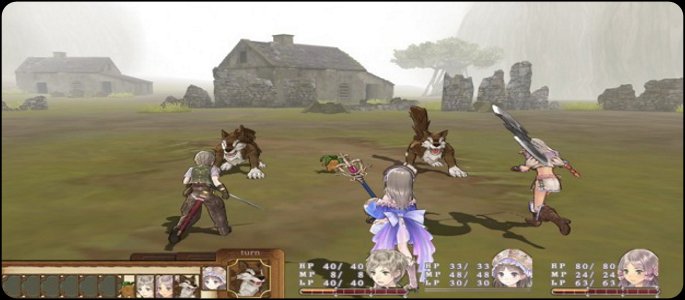The latest game in the Atelier series has finally made its way out here to Western audiences, bringing with it a light-hearted story and plenty of adventuring to the table. Players will revisit the world of Arland two years after the events of the first game, Rorona. The trip isn’t a smooth one and though there are some definite upgrades to the game, there is still just something missing in this series. Read on for the rest of our look at Atelier Totori: The Adventurer of Arland.
Atelier Totori takes place two years after its prequel, Atelier Rorona, and places gamers in the shoes of Totooria Helmold, an alchemist in training who has her eyes set on becoming one of the best adventurers around, just like her mother. Totori’s mother disappeared on an adventure and, though everyone else has given up hope, Totori still believes her mother is alive, but to search for her, she must first get an adventurer license. On her way to getting this license and searching for her mother, Totori will meet new friends, work on her alchemy, and have the experience of a lifetime, though it may not be an experience for most gamers out there.
The story isn’t one that throws itself in your face and forces you to pay attention. Instead, in Atelier Totori, the story comes and goes at certain points in your exploration, kind of popping up unexpectedly to remind you that there is in fact a point to this all. This can be a double-edged sword, as it provides you more time to gather ingredients for your alchemy, but it also makes the story feel at times detached and brings about some serious pacing issues. Luckily, the game is backed by a more than average cast of characters, with all kinds of quirkiness oozing out to help pass the time, but it only passes it so far.
In Totori, the name of the game is adventuring. In fact, the only real deadline to the plot is that you must reach a certain adventurer rank every three years in the game or else its curtains for you. Outside of this, you are free to roam the world, pick up items, fight baddies, and blend together all kinds of ingredients for the perfect creation. To upgrade your adventurer license in the game, you must take on different tasks from the local bartenders. These tasks range from gathering items and killing off a certain number of enemies, to traveling across the globe or fully exploring each area of the map. On the surface, this may sound like one deep experience, after 10 quests or so, you will start to see the extremely repetitive nature of these tasks. There is really only so many ways to kill 5 of these, or gather 3 of these. Though for some, this open system of taking on tasks, roaming the world, and crafting items may be just what the doctor ordered. Each task you accept will carry with it a competition date and reward total. It will also give special bonuses to the player based on how quickly they finish it, so make sure to be quick about it for a few extra items.
After accepting the quests, you must now go out into the world and complete them. As you travel from place to place on the map, you will notice that each destination will tell you how many days it takes to travel there. Pay close attention to this and when your quests are due, so you’re not stuck out completing the quest when its deadline passes by. Whenever you enter the areas, you will have the option of fighting enemies and gathering ingredients from around the area. As you gather items in the area you will notice your gauge in the upper left corner going down. After gathering a few items, it will deplete and refill, which costs you a day in your adventure. To help you save some time, when you highlight an area on the main map, it will tell you the main ingredients located there and which monsters you might face, but it won’t do this for every area, as some show just a question mark. One area to item gathering that has actually taken a step down since Rorona is the scale of the areas where you search. There is less to see once you click on a place, however Gust has added more total locations to explore to make up for this.

Now, while you are out exploring, you will have to get your hands dirty and take of some blue puni’s or other enemies. Thankfully, the combat in Totori is a step up from what it was in Rorona, but it is still not enough. To trigger a battle, you simply run up to an enemy and slap him with your wand, starting a turn-based battle between you’re three characters and the enemies. Each character has the option of a basic attack or a special skill, though Totori has the best skill of all and that’s items. In fact, Totori and Rorona are the only characters with the ability to use items, so make sure to stock up before battle or you won’t last long. Created items in your workshop play a huge part in combat and characters can do follow-up attacks or block Totori right before an oncoming attack. The combat is by no means terrible and this time around it actually serves a purpose, allowing you to gain points to your license. However, there is still so much untapped potential in what could be a really great part of the game. Instead the combat feels at time like it brought its sword, but forgot its armor.
Now what would an Atelier game be without the Alchemy? Thankfully, this part of the game took what was good in Rorona and added some very nice tweaks to the system. In alchemy, Totori can make as many items as she wants until her MP gauge empties out and her ingredients are gone. Each item that is gathered or synthesized has a quality ranking from one to one hundred, with the higher quality items being the most desirable. Select the item you want to make, then pick the ingredients and mix them together in your cauldron. Once the item is completed, you will have the option to add traits to the item based off of a point value, which in turn adds quality to the item. Items with lower quality will do less damage in battle and will lower quality over time, so there is incentive to throw out the bad ingredients and find yourself only the best. These additions do a great job of pushing players to be picky about what they put in their stew and to improve items as many times as they can.
Developer Gust once again provides a solid audio and visual experience for gamers to enjoy. The amount of details in the characters and environments are top-notch, with the world and especially the world map really bursting with color and popping out at you. The audio is no slouch either, as music from Rorona makes an appearance and the theme song for Totori is very pleasing to the ears. If only the same could be said for the voice acting, which, like a JRPG, is completely hit-or-miss, though mostly miss. The voice work done for Totori is up to speed and really fits the character, but others are a pain to your ears, causing for more taps of the mute button then should be necessary. Thankfully, the original Japanese voice work has been added to ease your pain.
Aterlier Totori is not a game for everyone, as some gamers might find themselves bored with the gather and create formula, but it is still a solid RPG experience. The story won’t leap out and get you but does a good job of gradually building up and delivering a story not centered around demon’s or apocalyptic implications. The combat in the game does just enough to grab you attention without being overly flashy or deep. Atelier Totori is a game that is fundamentally solid across the board but doesn’t have any real area of WOW factor. The game is around 20 hours or so to complete and will offer a solid (there’s that word again) experience if you are willing to work through the horrible pacing. Don’t be surprised though if you find yourself getting bored a few hours in after completing your 10th gathering quest while waiting for the story scene to happen and breathe some life into you.
PlayStation LifeStyle’s Final Score
+/-Combat is Good but Lacks Anything to Make it Great -Quests are Repetitive and Get Boring Fast, Leaving a Sometimes Boring Grind. |
 |
–








